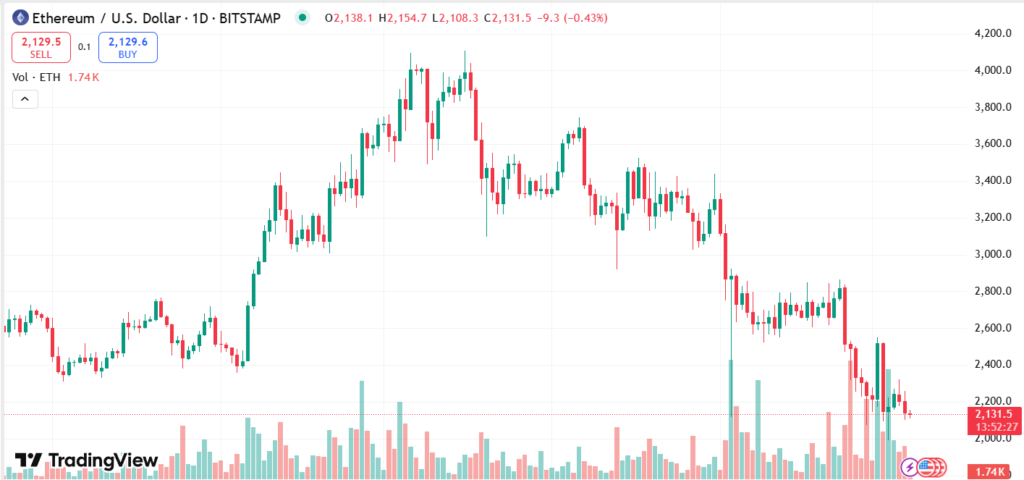Ethereum’s price has been pressured of late, falling to some $2,150 with the Market Value to Realized Value (MVRV) metric below 1, reflecting a pull back to the undervalued territory. This slide follows setbacks for the Pectra upgrade on Holesky and Sepolia testnets that pushed back the mainnet upgrade. The issues are being worked on by the developers, but if ETH doesn’t bounce above $2,200, then it has chances of falling lower to $1,500. Institutional investors, in spite of the bearishness, have been buying ETH, which reflects a chance for a bounce as soon as the upgrade issues are addressed.
KEY LOOKOUTS
• Pectra upgrade issues on Holesky and Sepolia testnets, yet to be fixed, could slow down Ethereum mainnet upgrade and influence market mood.
• Ethereum’s MVRV dipped below 1, indicating ETH is getting closer to its mean cost basis and potentially the lower end of the recovery zone.
• Should Ethereum not take out $2,200, however, it then risks plummeting further to stronger support levels down at $1,500 that could trigger increased bearish sentiment.
• Institutions are continuing to accumulate more ETH, signaling ongoing faith in the long-term price of Ethereum amidst short-term weak prices.

Ethereum is also experiencing major challenges, mainly caused by delays in the Pectra upgrade on the Holesky and Sepolia testnets, which are important for the mainnet update. This has been responsible for bearish sentiment in the market, as seen in the decline of Ethereum’s Market Value to Realized Value (MVRV) ratio to below 1, indicating that the price is getting close to the average cost basis of investors. If Ethereum is not able to re-take the $2,200 resistance zone, it may be at risk of sliding further towards the crucial support level of $1,500. While the price is weak now, institutional investors are aggressively buying ETH in this downturn, hinting that they have faith in its long-term prospects and signaling a potential reversal once the issues with the upgrade are solved.
Ethereum is facing delays in the Pectra upgrade, leading to a price drop towards the $2,150 level. If it does not recover above $2,200, ETH can fall to $1,500, although institutional accumulation indicates long-term growth potential.
• Pectra upgrade problems on Holesky and Sepolia testnets have led to delays in Ethereum’s mainnet upgrade, which has impacted market sentiment.
• Ethereum’s Market Value to Realized Value (MVRV) ratio fell below 1, which indicates that the price is close to the investors’ average buying cost, which might be a buy signal.
• Ethereum has dropped to $2,150 and is at risk of more declines if it doesn’t break the resistance of $2,200.
• Ethereum might go down further if it can’t bounce back above $2,200 and might go down further towards the next strong support level of $1,500.
• In spite of recent price declines, institutional investors have seen a substantial rise in ETH accumulation, indicating faith in Ethereum’s long-term prospects.
• The Relative Strength Index (RSI) and Stochastic Oscillator are indicating bearish momentum, which indicates a further downtrend unless a significant reversal takes place.
• A daily candlestick close above $2,850 would negate the bearish scenario, indicating the possibility of a near-term price recovery.
Ethereum is presently encountering issues as a result of delay in the Pectra upgrade, which has caused a hold-up in developing its mainnet. The upgrade, which offers considerable enhancements such as account abstraction and improved staking features, has faced technical difficulties during the test runs on the Holesky and Sepolia testnets. These have caused a bearish sentiment to arise in the market, where the price of Ethereum has suffered. Notwithstanding the hiccups, developers are in the process of fixing the problems and moving towards the successful rollout of the upgrade, which may make Ethereum more functional and scalable.
ETHEREUM DAILY PRICE CHART

CHART SOURCE: TradingView
Meanwhile, institutional investors have maintained interest in Ethereum, stockpiling additional tokens in spite of the price swings. This implies that there remains faith in Ethereum’s long-term worth, with these large investors believing that it has the ability to grow once the upgrade problems are solved. Although the market will likely stay wary in the short term, Ethereum’s continuous development and institutional investor support growth indicate that it might recover eventually and solidify its place within the cryptocurrency environment.
TECHNICAL ANALYSIS
Ethereum is under the influence of a bear trend currently, as the price finds it difficult to cross the resistance point of $2,200. The MVRV ratio going below 1 indicates that Ethereum is drawing closer to investors’ average cost basis, a region that generally is a point of accumulation. Yet, major technical gauges such as the Relative Strength Index (RSI) and the Stochastic Oscillator are indicating ongoing bearish momentum, which indicates that a further drop towards the $1,500 support level is imminent if the price cannot regain bullish momentum. A daily close above $2,850 would negate the prevailing bearish view and could indicate a reversal.

FORECAST
Despite the current difficulties, there is hope for a reversal if Ethereum is able to break the resistance at $2,200. Institutional investors have been busy buying up ETH, expressing faith in its long-term outlook. Once the Pectra upgrade is effectively implemented, it could introduce new functionality and improvements to the network, fueling optimism. If Ethereum is able to breach the $2,200 level, then the next potential target would be the $2,850 level, which would negate the prevailing bearish perspective and indicate a possible price bounce.
The price of Ethereum is under strong downward pressure as it is unable to breach the $2,200 resistance level. The ongoing setbacks in the Pectra upgrade, coupled with negative market sentiment, have contributed to Ethereum’s MVRV ratio falling below 1, indicating that the asset is underpriced. If Ethereum doesn’t bounce above $2,200, it could continue plummeting to the next significant support level of around $1,500, causing further selling. The Stochastic Oscillator and RSI are also indicating persistent bearish momentum, which implies that the risk of the downside is still dominant in the short term.






